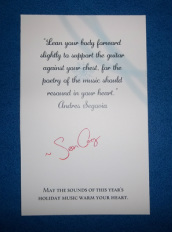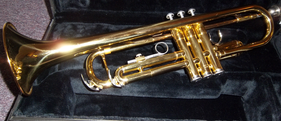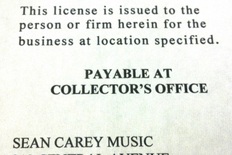 It's that time of year. That's right - resolutions! Do you remember the last ones you made? Me either. Most students will probably say that they need to practice more, and that's not a bad resolution to make. Just remember that by forming good practice habits, the quality of practices will become much better. Has your teacher asked you to do something over and over? Maybe you should put it on the list. Is there something you want to get better at? Add that, too. Here are a few examples you might add to your list of New Year's Resolutions:
You see, a list is a good thing to have because it helps organize our thoughts. The next step is to act on it, and make those resolutions happen.
Whatever you decide to put on your list this year, be sure that your goals are realistic. Start small. Be determined to do the best you can to succeed. Strive for excellence in your music. ♫ Sean
0 Comments
 One of the most important things you need to address when considering music lessons is getting an instrument in your hands or the hands of your child. For the beginning student, the cost of the instrument is less important than the quality of the instrument. As students mature musically, they become aware of the craftsmanship of their instrument and may eventually outgrow the one they have been using. This will inevitably lead to the student looking to purchase or obtain a new instrument that meets their needs. However, cost can be a major obstacle for many people, which often pushes them into a mindset of "what can I afford?" rather than "what is best for me (or my child)?" When possible, it is always best to ask for recommendations from professional music teachers prior to making a purchase or renting an instrument. Sadly, this isn't always an option. So what do you do? My opinion is that before you purchase or rent an instrument, you know without a doubt that you need to acquire one. The instrument you have collecting dust in the attic might be just fine for beginner lessons. Do you know someone who has an instrument you can borrow for a few weeks while you decide if taking lessons is what you really want? Ask them if you can borrow it, or if they know someone who has one that might let you play it for awhile. This really is the first step - determining the need to acquire the instrument. Music stores that also give lessons will oftentimes direct you to purchase or rent one of their instruments, even if the instrument isn't a good fit for you. This is because they rely on sales as well as lesson revenue. Be sure you trust the person you speak with at the store before you make your decision at these places. Many stores can give you very helpful information that will help you decide what's right for you, especially smaller local stores with a good reputation. If you have already addressed this question seriously, the next step is to determine whether to rent or buy. You may not have the luxury of being able to rent in your area, but even if there are no music stores near you, there are always online dealers you can order from. Personally, I recommend trying out an instrument BEFORE you buy it, for many reasons, but if this is the only option for you then I suggest doing your research and read reviews on the instruments you're interested in. Purchasing an instrument up front is the right decision for some people. If you know you're going to play for a long time, or you feel you can get a better deal by doing so, then buying an instrument might be the best way to go. If you own the instrument, you can always sell it later on if you no longer play it. You won't have to worry about monthly payments. You won't have to report damages like scratches and dents that happen from time to time. The best part is that YOU OWN IT, and the instrument is completely yours - you can do with it as you please. However, owning an instrument means that if something happens to the instrument to cause it to become damaged and need repaired, you will have to take care of that yourself (take it to a shop, or do the repairs on your own). Unless you carry insurance on your instrument - and most people don't - you will have to front the cash to get the instrument into playable condition again. Renting an instrument is the other option. When you rent an instrument, you often will be asked for a down payment and then you continue to make monthly payments for as long as you own the instrument. Damage can still happen, but your rental agreement or contract should spell out the details of repairs and maintenance. Pay close attention to the contract because you might end up paying for the damages incurred! The best part about renting is that there is a much smaller cost up front. You can walk out the door with a rental instrument in hand and then you continue to benefit from having that instrument as long as you continue to make payments. The best option for renting is a "rent-to-own" program. These programs allow you to make your rental payments as normal, but each time you make a payment, a portion of that payment is applied toward the total cost of the instrument, allowing you to pay it off over time. Once you have paid for the cost of the instrument, you become the new owner of the instrument. There are disadvantages to this option as well. Depending on your rent-to-own agreement, you may end up spending far more than the instrument is worth. You need to determine this first, before you enter into any instrument rental agreement. The second drawback is that by the time you have paid for the instrument, it may be time to purchase or rent another one! This happens frequently with young students who literally outgrow their instrument. Renting an instrument might be better if you are concerned about your child needing a new instrument within a year or two. There is no right or wrong answer here. The right decision is the one that best suits your needs (or your child's needs). You may find that by spending a few dollars on a cheap "toy" guitar from the chain retail store gives you an opportunity to discover that you really aren't as interested as you once thought (also very common with children). Or you may find that you really do want to continue to learn to play the instrument, and then you can move forward into a rental arrangement or purchase an instrument knowing that you've made the right choice. Unfortunately, cheap instruments are pretty terrible instruments to learn on... they're really designed as toys rather than instruments. But once you've made your informed decision, you'll feel more at ease parting with the rental fee or purchase price later on. Finally, as a note of caution, I suggest spending time with any instrument BEFORE you purchase or rent it. During these moments you may find something needs fixed, or is the wrong size, or simply doesn't suit you. whatever you do, be sure to ASK QUESTIONS when considering your purchase. A little time spent before you buy will help you get the best quality instrument for your money. ♫ Sean I'm often asked what age is appropriate for a child to start guitar lessons. I completely understand where this question comes from, as it usually stems from parents who have heard other teachers recommend they wait until the child is older. There are reasons for this, and I feel I should address these first, as they are valid concerns on the part of the teacher.
To begin with, young children - especially children between 5 and 10 years old - have much smaller hands and fingers than their adult parents. Naturally this poses a problem if the instrument is a full-size guitar. There are half-size and 3/4-size guitars available from reputable makers that are scaled to fit a child's hands and the reach of their smaller arms. These guitars will feel much more comfortable to the child and they will find they are better able to 'handle' the instrument. However, there is more to the concern than just the instrument's size. Young children are still developing their fine and gross motor skills, both of which are required to play the guitar - especially fine motor skills. If the child is not able to control their fingers and press firmly on the strings, they will not be able to produce good tone. Students need to keep their fingers arched and relaxed for relatively long periods of time (up to a few minutes, which is taxing on small hands that are not yet fully developed). One common workaround for this is to have the child play with nylon strings, which are generally slightly thicker than steel strings and far less painful for soft, young fingers. Young children may also have difficulty reaching the frets on the guitar. Playing a note in the first fret and the third fret simultaneously can be a real stretch for them. One way to bypass this problem is by teaching them to play higher on the neck. This can be done while still teaching notes and scales and chords. Some teachers may opt to have the student use a capo, which raises the pitch of all the strings and allows the student to play higher on the neck of the guitar while still reading music intended to be played lower on the instrument. Another concern is the attention span of young students. A 7-year-old should not be expected to be able to focus on much more than a short passage or two at a time. Some students are more capable of focusing their effort on playing than others, and the amount of music you give them to practice will likely vary between students. This is one of the most stressful factors for teachers of young musicians, and I feel is also the least important. Lessons are often structured in 30-minute sessions, which is fairly standard for private lessons and even many (I daresay most) college-level lessons. Understanding that your young student may not be able to apply focus for that amount of time is key to maximizing the effectiveness of your lesson. If a student becomes tired or disinterested during a lesson, it is time to change the focus. Perhaps move on to another technique or song, or integrate other concepts into the lesson. Puzzles that teach young musicians to recognize intervals might be a valuable use of that time. At the end of the lesson, you might go back and play through exercises the student has already completed, thus cementing those skills into their minds and giving them a sense of mastery over their musicianship. Finally, a child's ability to practice regularly each week is a major issue. If the child is unwilling or unable to practice a reasonable amount of time, they will progress much slower than when they do practice, if they progress at all. If your child shows interest and demonstrates the ability to handle the responsibility that practicing requires, then they may do well with guitar lessons. Having considered these issues, I've found that the only way to really know if a child is ready for guitar lessons is to put a guitar in their hands and see what happens. I know many well-meaning parents run to the nearest "Buy-Mart" and purchase a colorful and properly-sized, but poorly manufactured and barely tunable instrument. I do not recommend these guitars for anyone intending to use them for lessons. However, I do see the value in allowing a child to explore this 'toy guitar' to see how deep their interest really is before investing in a proper instrument. This way, parents can gauge their child's interest without spending much money initially. I teach young children to play guitar and make accommodations with almost every student, including the methods described above. Each child will have different needs and abilities, though, so your teacher must take all of this into consideration. In some instances, a teacher may have to decline to teach a child. Making that call will differ between teachers, and if a teacher tells you they won't teach under a certain age, don't be afraid to ask why. They may even have other ideas for you that may be helpful. ♫ Sean  So okay. Many of you understand how private music lessons are conducted. You pay a qualified teacher to teach you or your child and in return you pay a weekly or monthly fee, sometimes called 'tuition' to the instructor or music school. But there are many folks who don't seem to understand why teachers set the rates they do. Recently, I wrote a short article in the Studio newsletter titled 'Where does all my tuition money go?' Here it is: "The tuition paid by students every month covers much more than just the thirty minute lesson. It also covers preparation time and expenses for instructional materials, printing costs, office supplies and Studio expenses, incentives for students, bookkeeping, trips to local music shops, your instructor’s training and professional development, professional organization memberships maintained by the instructor, taxes, newsletters, travel expenses and vehicle maintenance, business license fees, website design and fees, Studio promotional items and advertising. They say that time is money, and in the case of a music studio, it is really true. All these things make it possible to provide quality lessons for all students. Rates and fees are kept as low as possible to keep them affordable and competitive." There is a high price to operate a small music studio, and many teachers simply stop at the thirty minute lesson, effectively bypassing the higher costs associated with running an actual studio. You see, part of running a studio is running a business. Who pays the business fees and taxes? I do. Who pays for materials and printing and office supplies such as ink and paper? I do. Who pays for the internet connection and maintenance of digital devices? What about strings for guitars, picks and books and lesson materials? What about all the time it takes to personalize each lesson to each individual student? Advertising costs? That's right, just me. Did you I also pay for internet service provider fees, website hosting and email? Or how about the ever-rising gasoline prices I pay to fuel my vehicle in order to bring lessons to your home? How is it even possible to keep up with all of that? You might say, "Just get more students." That's very hard to do if you only offer a thirty minute lesson and do absolutely nothing to promote your service. For private music teachers, it is a constant struggle to keep a studio growing. When I restructured my payment policy in March, I abandoned the payment-by-week method and opted for a set monthly rate. That change means that now a student can expect 50 lessons per year and the cost increased only 60 cents per lesson. Sixty cents! That is not even enough to cover travel expenses per student. So far I have been able to keep my Studio tuition rates affordable, and comparatively my rates are on the low end. Incidentally, there are no plans for a tuition increase for the 2014 year at this time. So the next time you hear someone beleaguer the cost of private lessons, go ahead and remind them where all the money really goes. Music teachers everywhere will thank you. ♫ Sean  I'm excited to offer this blog as a new facet of the Studio! My goal for this blog is to open up conversation on a wide variety of musical topics relating to music education, private instruction, musicianship, and private studio business matters. Whether you are a student or teacher, there is something here for you. STUDENTS & MUSICIANS Students will find many insightful posts here and are encouraged to comment on them. You don't have to be a student of Sean Carey Music to get involved! Anyone who visits this site can join in at any time. TEACHERS Teachers, your input is valuable as well! Most of the topics found on this blog relate directly to teaching in a private studio, but many of them have value across the wide and diverse spectrum of music education. Your insights are valuable to all of us who teach music. ♫ Sean |
Studio BlogDiscussions on topics related to musicianship. Archives
January 2016
Categories
All
|
|
© 2012-2023 Sean Carey Music LLC.
All Rights Reserved. |

 RSS Feed
RSS Feed

